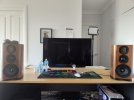thedantestyle
Member
- Joined
- Dec 2, 2022
- Messages
- 9
- Likes
- 14
So I made another thread a few days ago asking about whether I should get studio monitors or hifi speakers for good imaging sitting at my desk.
I currently own a couple of Wharfedale evo 4.2 speakers (3-way) - I believed - and many suggested these speakers would be no good for nearfield listening.
So today I went to a hifi store to test out some new speakers - I had him set them all up the same distance I'd be listening - they sounded pretty great - Had amazing imaging - and clearly defined center image for vocals etc.
Anyway, before I decided to purchase a set - I asked him to set up my speakers in the same position (he happened to have evo 4.2 in store) Just so I'd be sure the new speakers imaged better.... Lo and behold my speakers were AMAZING! Even better imaging nearfield than the ones I was going to buy.
So admittedly my desk is not the same as listening to speakers on floor stands (as they were in store) - So I pulled my speakers to the end of the desk to eliminate reflections from the monitor and desk - Ive attached a photo - but the image didn't improve one little bit. I've tried different toe-in angles as well.
The store owner suggested it could be my amp - but I suspect it's something in my setup/reflections going on.... What would you suggest I do next to get my imaging happening properly? Could it really be my amp? I'm using an onkyo tx-sr602 receiver which admittedly isn't amazing, but would it really kill my imaging? I could drive to the store with my amp but it's almost 2 hours drive away.
I currently own a couple of Wharfedale evo 4.2 speakers (3-way) - I believed - and many suggested these speakers would be no good for nearfield listening.
So today I went to a hifi store to test out some new speakers - I had him set them all up the same distance I'd be listening - they sounded pretty great - Had amazing imaging - and clearly defined center image for vocals etc.
Anyway, before I decided to purchase a set - I asked him to set up my speakers in the same position (he happened to have evo 4.2 in store) Just so I'd be sure the new speakers imaged better.... Lo and behold my speakers were AMAZING! Even better imaging nearfield than the ones I was going to buy.
So admittedly my desk is not the same as listening to speakers on floor stands (as they were in store) - So I pulled my speakers to the end of the desk to eliminate reflections from the monitor and desk - Ive attached a photo - but the image didn't improve one little bit. I've tried different toe-in angles as well.
The store owner suggested it could be my amp - but I suspect it's something in my setup/reflections going on.... What would you suggest I do next to get my imaging happening properly? Could it really be my amp? I'm using an onkyo tx-sr602 receiver which admittedly isn't amazing, but would it really kill my imaging? I could drive to the store with my amp but it's almost 2 hours drive away.

